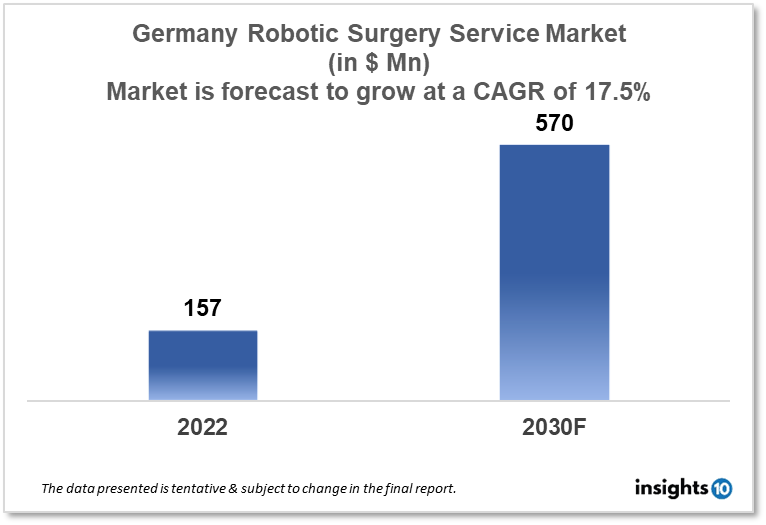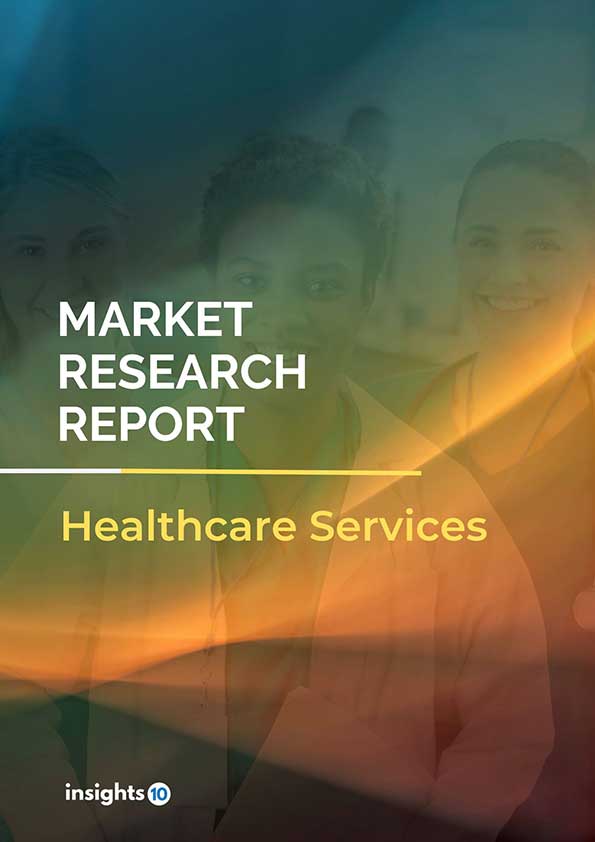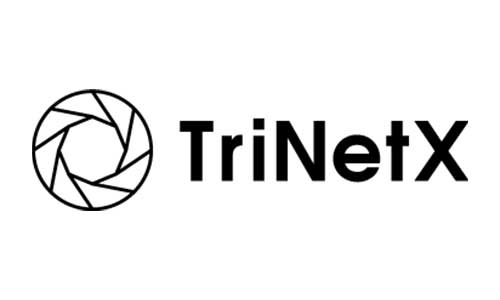Germany Robotic Surgery Services Market Analysis
Germany's robotic surgery service market size was valued at $157 Mn in 2022 and is estimated to expand at a CAGR of 17.5% from 2022-30 and will reach $570 Mn in 2030. The robotic surgery service market will grow due increasing availability of advanced medical technologies, such as sophisticated surgical robots and imaging systems. The market is segmented by product and service type, application type, and end user. Some of the major players are Richard Wolf GmbH, Medtronic GmbH, Stryker Corporation, Smith & Nephew, and others.
Buy Now

Germany Robotic Surgery Service Market Executive Summary
Germany's robotic surgery service market size was valued at $157 Mn in 2022 and is estimated to expand at a compound annual growth rate (CAGR) of 17.5% from 2022 to 2030 and will reach $570 Mn in 2030. has been steadily increasing in recent years. According to recent estimates, total healthcare spending in Germany was approximately 350 Bn euros in 2020. This represents a significant portion of the country's gross domestic product (GDP) and reflects the high value that German citizens place on their health and well-being.
Robotic surgery is a growing field in Germany and is being increasingly used in a wide range of medical procedures. The use of robotic surgery offers several benefits, including improved accuracy and precision, shorter hospital stays, and faster recovery times for patients.
In Germany, robotic surgery is widely available in many of the country's leading hospitals and medical centers and is being used for a variety of procedures, including gynecological surgery, urologic surgery, and cardiothoracic surgery, among others. Some of the most common procedures performed using robotic surgical systems in Germany include prostatectomies, hysterectomies, and mitral valve repairs. Despite its growing popularity, the use of robotic surgery in Germany is subject to a number of regulations and guidelines, including those related to patient safety, surgeon training, and device approval. These regulations are designed to ensure that patients receive the highest quality of care and that the use of robotic surgical systems is done in a safe and effective manner.
In terms of reimbursement, most robotic surgery procedures performed in Germany are covered by the country's public healthcare system, the statutory health insurance. However, the exact level of coverage can vary depending on the specific procedure, the patient's insurance plan, and other factors. Hence, the robotic surgery service market will grow in the coming years.

Market Dynamics
Market Growth Drivers
The market for robotic surgery services in Germany is driven by several factors, including the growing demand for minimally invasive surgical procedures, the increasing availability of advanced medical technologies, and the aging of the population.
One of the main drivers of the market is the growing demand for minimally invasive surgical procedures. Robotic surgery is widely considered to be one of the most minimally invasive surgical approaches available and is seen as an attractive option for many patients due to its relatively small incisions, reduced pain and scarring, and faster recovery times.
Another factor driving the market is the increasing availability of advanced medical technologies, such as sophisticated surgical robots and imaging systems. The development of these technologies has made it possible for surgeons to perform a wider range of procedures with greater precision and accuracy and has helped to increase the overall popularity of robotic surgery services in Germany.
Moreover, the aging of the population is another important driver of the market. As the number of older adults in Germany continues to grow, the demand for medical services, including surgical procedures, is expected to increase. This is likely to drive further growth in the market for robotic surgery services in the coming years.
Market Restraints
There are also several factors that may serve as potential restraints on the growth of the market for robotic surgery services in Germany. These include concerns about the safety and effectiveness of robotic surgical procedures, as well as the high cost of the technology and related equipment. Additionally, the shortage of skilled surgeons trained in the use of robotic surgical systems may also pose a challenge to the growth of the market in the coming years.
Competitive Landscape
Key Players
- Richard Wolf GmbH
- Medtronic GmbH
- Stryker Corporation
- Smith & Nephew
- TransEnterix Surgical, Inc.
- Renishaw plc.
- Intuitive Surgical
- Zimmer Biomet
Healthcare Policies and Regulatory Landscape
In Germany, regulations for robotic surgery services are primarily governed by the German Medical Devices Act (Medizinproduktegesetz), which sets the standards for the design, manufacture, and sale of medical devices, including surgical robots.
The Federal Institute for Drugs and Medical Devices (BfArM) is the regulatory body responsible for overseeing the approval and certification of medical devices, including surgical robots, in Germany.
Policy Changes and Reimbursement Scenario
Surgical robots must undergo a thorough evaluation process, including clinical trials, to demonstrate their safety and efficacy before they can be approved for use in the country. In addition, medical facilities using surgical robots must have trained personnel, adequate insurance coverage, and an established system for monitoring and reporting adverse events.
In Germany, reimbursement for robotic surgery services is primarily governed by the German statutory health insurance system, which is a social health insurance system that covers approximately 85% of the population. Reimbursement for surgical procedures, including those performed using robots, is based on the German Diagnosis Related Groups (DRG) system, which assigns a specific reimbursement amount to each procedure based on the diagnosis, procedure, and resource utilization. Reimbursement for robotic surgery services may also be influenced by agreements between health insurance providers and medical facilities, as well as by individual contracts between patients and medical facilities.
1. Executive Summary
1.1 Service Overview
1.2 Global Scenario
1.3 Country Overview
1.4 Healthcare Scenario in Country
1.5 Healthcare Services Market in Country
1.6 Recent Developments in the Country
2. Market Size and Forecasting
2.1 Market Size (With Excel and Methodology)
2.2 Market Segmentation (Check all Segments in Segmentation Section)
3. Market Dynamics
3.1 Market Drivers
3.2 Market Restraints
4. Competitive Landscape
4.1 Major Market Share
4.2 Key Company Profile (Check all Companies in the Summary Section)
4.2.1 Company
4.2.1.1 Overview
4.2.1.2 Product Applications and Services
4.2.1.3 Recent Developments
4.2.1.4 Partnerships Ecosystem
4.2.1.5 Financials (Based on Availability)
5. Reimbursement Scenario
5.1 Reimbursement Regulation
5.2 Reimbursement Process for Services
5.3 Reimbursement Process for Treatment
6. Methodology and Scope
Robotic Surgery Services Market Segmentation
By Product and Services (Revenue, USD Billion):
The surgical robotics market volume data has been covered for all the major surgical robotics systems. In terms of value, the surgical systems market is anticipated to expand at a CAGR of 11.22% from 2018 to 2025.
- Instruments and Accessories
- Robotic Systems
- Services
By Application (Revenue, USD Billion):
Gynecology accounted for the largest market share in 2017 and is anticipated to expand at a CAGR of 7.0% from 2018 to 2025. This is explained by the rising prevalence of gynecological complications in women worldwide and the ongoing development of robotic technologies.
- General Surgery
- Gynecological Surgery
- Urological Surgery
- Neurosurgery
- Orthopedic Surgery
- Other Applications
By End User (Revenue, USD Billion):
The hospitals segment had the largest market value in 2017 and experienced a CAGR of 13.20% from 2018 to 2025. However, during the projected period of 2018–2025, the ambulatory surgical center's income is predicted to rise at the highest CAGR of 18.20%.
- Hospitals
- Ambulatory Surgery Centers
Methodology for Database Creation
Our database offers a comprehensive list of healthcare centers, meticulously curated to provide detailed information on a wide range of specialties and services. It includes top-tier hospitals, clinics, and diagnostic facilities across 30 countries and 24 specialties, ensuring users can find the healthcare services they need.
Additionally, we provide a comprehensive list of Key Opinion Leaders (KOLs) based on your requirements. Our curated list captures various crucial aspects of the KOLs, offering more than just general information. Whether you're looking to boost brand awareness, drive engagement, or launch a new product, our extensive list of KOLs ensures you have the right experts by your side. Covering 30 countries and 36 specialties, our database guarantees access to the best KOLs in the healthcare industry, supporting strategic decisions and enhancing your initiatives.
How Do We Get It?
Our database is created and maintained through a combination of secondary and primary research methodologies.
1. Secondary Research
With many years of experience in the healthcare field, we have our own rich proprietary data from various past projects. This historical data serves as the foundation for our database. Our continuous process of gathering data involves:
- Analyzing historical proprietary data collected from multiple projects.
- Regularly updating our existing data sets with new findings and trends.
- Ensuring data consistency and accuracy through rigorous validation processes.
With extensive experience in the field, we have developed a proprietary GenAI-based technology that is uniquely tailored to our organization. This advanced technology enables us to scan a wide array of relevant information sources across the internet. Our data-gathering process includes:
- Searching through academic conferences, published research, citations, and social media platforms
- Collecting and compiling diverse data to build a comprehensive and detailed database
- Continuously updating our database with new information to ensure its relevance and accuracy
2. Primary Research
To complement and validate our secondary data, we engage in primary research through local tie-ups and partnerships. This process involves:
- Collaborating with local healthcare providers, hospitals, and clinics to gather real-time data.
- Conducting surveys, interviews, and field studies to collect fresh data directly from the source.
- Continuously refreshing our database to ensure that the information remains current and reliable.
- Validating secondary data through cross-referencing with primary data to ensure accuracy and relevance.
Combining Secondary and Primary Research
By integrating both secondary and primary research methodologies, we ensure that our database is comprehensive, accurate, and up-to-date. The combined process involves:
- Merging historical data from secondary research with real-time data from primary research.
- Conducting thorough data validation and cleansing to remove inconsistencies and errors.
- Organizing data into a structured format that is easily accessible and usable for various applications.
- Continuously monitoring and updating the database to reflect the latest developments and trends in the healthcare field.
Through this meticulous process, we create a final database tailored to each region and domain within the healthcare industry. This approach ensures that our clients receive reliable and relevant data, empowering them to make informed decisions and drive innovation in their respective fields.
To request a free sample copy of this report, please complete the form below.
We value your inquiry and offer free customization with every report to fulfil your exact research needs.








































